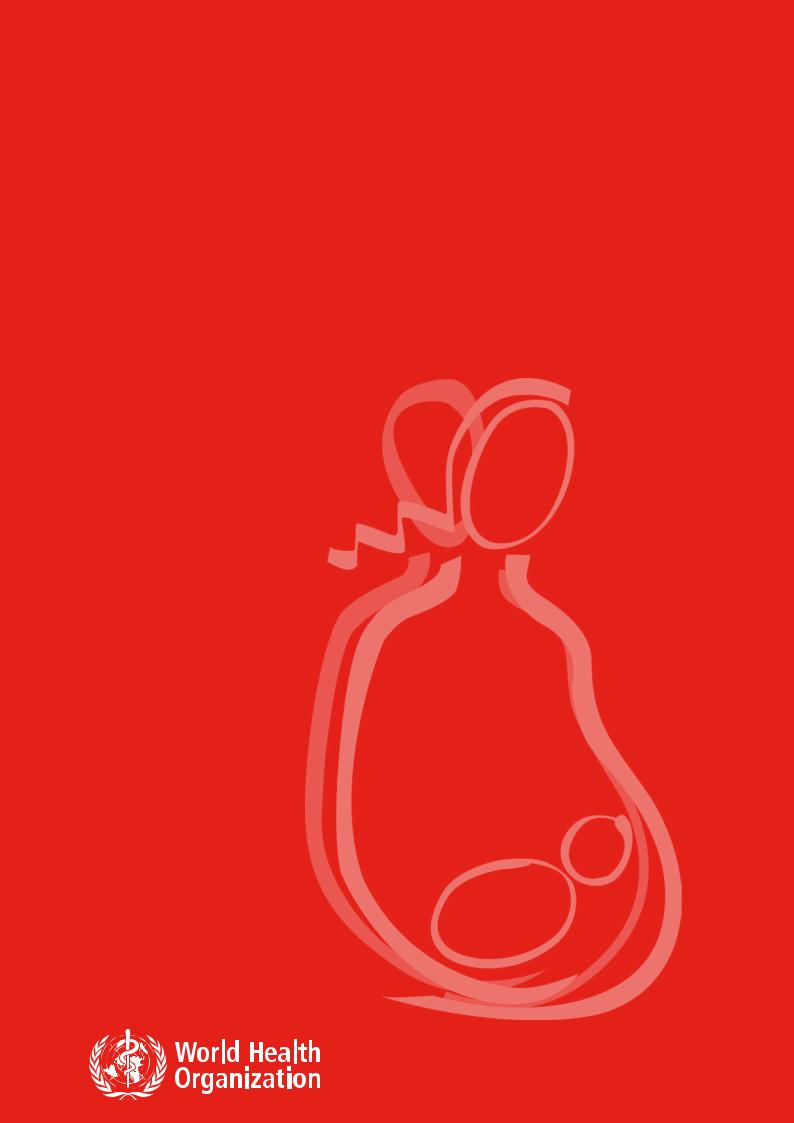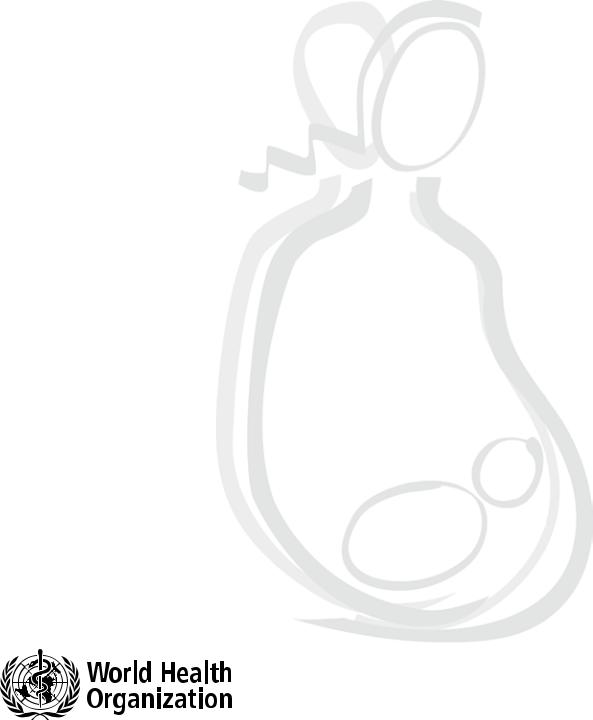
гос акушня3 / акушня!!!!!!!!! / АкушКровотечПисьмо / recommendations_pph
.pdf
WHO Recommendations for the Prevention of Postpartum Haemorrhage
Department of Making Pregnancy Safer

WHO Recommendations for the Prevention of Postpartum Haemorrhage
Department of Making Pregnancy Safer

WHO/MPS/07.06
ACKNOWLEDGEMENTS
This document was prepared by Matthews Mathai (Department of Making Pregnancy Safer) in collaboration with A Metin Gülmezoglu (Department of Reproductive Health and Research) and Suzanne Hill (Department of Medicines Policy and Standards) based on the WHO Technical Consultation on Prevention of Postpartum Haemorrhage held in Geneva, October 18-20, 2006.
The contributions of the chairman (James Neilson) and the international panel of experts, the assistance of the Centro per la Valutazione della Efficacia della Assistenza Sanitaria (Centre for the Evaluation of Effectiveness of Health Care, CeVEAS), Modena, Italy (N Magrini, V Basevi, G Gori, S Pregno, S Di Mario, D Spettoli), and support from PATH's Prevention of Postpartum Hemorrhage Initiative (POPPHI) and USAID are gratefully acknowledged.
Technical editing was done by R P Casna and layout by Paprika, Annecy.
© World Health Organization 2007
All rights reserved. Publications of the World Health Organization can be obtained from WHO Press, World Health Organization, 20 Avenue Appia, 1211 Geneva 27, Switzerland (tel.: +41 22 791 3264; fax: +41 22 791 4857; e-mail: bookorders@who.int). Requests for permission to reproduce or translate WHO publications – whether for sale or for noncommercial distribution – should be addressed to WHO Press, at the above address (fax: +41 22 791 4806; e-mail: permissions@who.int).
The designations employed and the presentation of the material in this publication do not imply the expression of any opinion whatsoever on the part of the World Health Organization concerning the legal status of any country, territory, city or area or of its authorities, or concerning the delimitation of its frontiers or boundaries. Dotted lines on maps represent approximate border lines for which there may not yet be full agreement.
The mention of specific companies or of certain manufacturers’ products does not imply that they are endorsed or recommended by the World Health Organization in preference to others of a similar nature that are not mentioned. Errors and omissions excepted, the names of proprietary products are distinguished by initial capital letters.
All reasonable precautions have been taken by the World Health Organization to verify the information contained in this publication. However, the published material is being distributed without warranty of any kind, either expressed or implied. The responsibility for the interpretation and use of the material lies with the reader. In no event shall the World Health Organization be liable for damages arising from its use.
Printed by the WHO Document Production Services, Geneva, Switzerland
TABLE OF CONTENTS
1. |
BACKGROUND |
4 |
|
|
|
|
|
2. |
METHODS |
6 |
|
|
|
|
|
3. |
RESULTS |
7 |
|
|
|
|
|
4. |
EVIDENCE AND RECOMMENDATIONS |
9 |
|
|
|
|
|
5. |
KEY DISCUSSION POINTS |
17 |
|
|
|
|
|
6. |
REFERENCES |
20 |
|
|
|
|
|
7. |
ANNEXES |
22 |
|
|
1. |
Questions for Panel |
22 |
|
2. |
List of Outcomes |
24 |
|
3. |
Methods used for developing guidelines |
25 |
|
4. |
GRADE Evidence Profiles |
32 |
|
5. |
List of Participants |
34 |

BACKGROUND
Bleeding after childbirth (postpartum haemorrhage) is an important cause of maternal mortality, accounting for nearly one quarter of all maternal deaths worldwide. Common causes for postpartum haemorrhage (PPH) include failure of the uterus to contract adequately after birth leading to atonic PPH, tears of the genital tract leading to traumatic
PPH and bleeding due to retention of placental tissue. Atonic PPH is the most common cause of PPH and the leading cause of maternal death.
Attempts have been made to identify women at risk of atonic PPH based on historical or clinical factors and steps are planned to prevent it in this allegedly high-risk group of women. Unfortunately, atonic PPH can occur even in women without identifi able risk factors. Numerically, more women without risk factors have atonic PPH compared to those with risk factors. To prevent atonic PPH, interventions should therefore be targeted at all women during childbirth.
One intervention that has been promoted as an effective intervention in preventing atonic PPH is the active management of the third stage of labour. This intervention was described in the Cochrane review as a package comprising the following interlocking interventions: administration of a prophylactic uterotonic after delivery of the baby, and usually also early cord clamping and cutting, and controlled traction of the umbilical cord.1 According to the International Confederation of Midwives (ICM) and the International Federation of Gynecology & Obstetrics (FIGO), the usual components of active management include administration of uterotonic agents, controlled cord traction and uterine massage after delivery of the placenta, as appropriate;2 while in WHO's Integrated Management of Pregnancy and Childbirth guidelines, the steps in active management of third stage of labour involve giving oxytocin immediately, delivery of the placenta by controlled cord traction and uterine massage.3 In the two latter defi nitions, the word "early" was left out because of evidence suggesting benefi ts of delayed cord clamping for the baby. It is also known that the timing of "early" cord clamping has not been consistent in the active management arms of the trials.
4 WHO Recommendations for the Prevention of Postpartum Haemorrhage

In contrast to active management, expectant management involves waiting for signs of separation and allowing the placenta to deliver spontaneously, or aided by gravity or nipple stimulation.1 Expectant management is also known as conservative or physiological management.
While there is general agreement on the beneficial effects of active management of the third stage of labour, there are several issues which are yet to be resolved, such as clear definitions on the individual components of the intervention, the best methods and the requirements for the safe administration of this intervention under conditions of limited resources. For example, how soon after birth should the uterotonic be administered?
Which drug should be recommended for different settings? What is the best route of administration? Is early clamping of the cord necessary and if so, what does "early" mean?
Traction on the cord before separation of the placenta from the uterus may increase the risk of maternal complications. Is it a procedure that can be carried out safely by "nonskilled" providers?
Injectable oxytocin has been recommended for routine use in the active management of the third stage of labour;3 however, administration of an injection requires skills and sterile equipment for safe administration. Oxytocin may be inactivated if exposed to high ambient temperatures.4
Misoprostol, a prostaglandin analogue with uterotonic effects, is reportedly more stable than oxytocin and has been administered by oral, sublingual and rectal routes in several studies.5 Suggestions have been made to provide misoprostol tablets where oxytocin is not available6 to non-skilled providers7 and to women themselves for the prevention of PPH;8 however, there are concerns that misuse of misoprostol can lead to significant maternal morbidity and even death.
In the light of these issues, the World Health Organization held a Technical Consultation on the Prevention of Postpartum Haemorrhage in Geneva on 18–20 October 2006 to discuss the various issues related to prevention of PPH and to develop recommendations.
WHO Recommendations for the Prevention of Postpartum Haemorrhage

METHODS
•WHO staff from the departments of Making Pregnancy Safer, Reproductive Health and Research, and Medicines, Policies and Standards drafted questions on various interventions described for prevention of atonic postpartum haemorrhage (active management of third stage of labour and its components). Each question was subdivided to address issues related to the type of health-care provider – skilled or non-skilled. For this discussion, the term "skilled attendant" refers exclusively to people with midwifery skills (for example, midwives, doctors and nurses) who have been trained to profi ciency in the skills necessary to manage normal deliveries and diagnose, manage or refer complications.9 10 Skilled attendants must be able to manage normal labour and delivery, recognize the onset of complications, perform essential interventions, start treatment and supervise the referral of mother and baby for the interventions that are beyond the attendants’ competence or not possible in the particular setting. Depending on the setting, other health-care providers, such as auxiliary nurse/midwives, community midwives, village midwives and health visitors, may also have acquired appropriate skills if they have been specially trained. Non-skilled attendants are those care providers who do not satisfy the above conditions. In making recommendations, participants of the
Technical Consultation also considered making a distinction regarding the skills needed as defi ned above and the skills needed to make a safe intramuscular injection. A set of key benefi cial and harmful outcomes of interventions was also drafted by WHO staff
(Annexes 1 & 2), based mainly on published systematic reviews.
•These questions and proposed outcomes to consider were sent by e-mail to an international panel of experts (midwives, obstetricians, neonatologists, researchers, programme experts). Members of the panel were invited to comment on the relevance of these questions, to modify them if required and to add additional relevant questions. Panel members were also asked to rate each benefi cial and harmful outcome on a scale of 1-9. A critical outcome was defi ned as an outcome that scored on average between 7 and 9. Those outcomes that scored between 4 and 6 on average were considered "important but not critical", while those scoring less than 4 were considered "not important".
•All responses were reviewed by the WHO core team. Where necessary, reminders were sent to members of the expert panel.
•An external organization, Centro per la Valutazione della Effi cacia della Assistenza
Sanitaria (Centre for the Evaluation of Effectiveness of Health Care) (CeVEAS), Modena,
Italy, founded by the Public Health Service, was commissioned to review and grade the evidence to answer the questions asked using the GRADE methodology (Annexe 3). Draft evidence tables prepared by CeVEAS were reviewed by the WHO core team along with staff from CeVEAS. Evidence-based recommendations in response to the questions asked were then drafted.
•A draft of the methodology, results and recommendations was sent for review to a sub-group of experts prior to their participation in the WHO Technical Consultation on
Prevention of Postpartum Haemorrhage.
•This draft and the supporting evidence were reviewed at the Technical Consultation in Geneva on 18–20 October 2006 and changes were made based on the recommendations of the expert panel.
6 WHO Recommendations for the Prevention of Postpartum Haemorrhage

RESULTS
•The draft questions related to prevention of PPH and the scoring grid for benefi cial and harmful outcomes of interventions were sent to 58 experts from all six WHO regions.
•Responses were received from 37 of these experts. Questions were modifi ed based on feedback received. The table below shows the average scores assigned to benefi cial and harmful outcomes by this group.
•Based on this ranking, the critical beneficial outcomes for making a recommendation were:
•reduction in maternal mortality and
•reduction in maternal morbidity as indicated by
>measured blood loss of 1 l or more, and
>use of blood transfusion.
•Adverse effects of the drugs, including manual removal of the placenta, were considered important harms of the intervention, but not considered critical for decision-making.
Table 1 : Average scores
What are the most important benefi cial outcomes of interventions to prevent PPH?
Fewer maternal deaths |
8.5 |
Fewer admissions to intensive care unit |
6.4 |
Less blood loss > 500 ml |
6.3 |
Less blood loss > 1000 ml |
7.7 |
Less use of blood transfusion |
7.8 |
Less use of additional uterotonics |
5.9 |
Decreased mean blood loss |
5.6 |
Less postpartum anaemia |
6.1 |
Earlier establishment of breastfeeding |
5.1 |
Less anaemia in infancy |
4.8 |
Other (please specify) |
|
WHO Recommendations for the Prevention of Postpartum Haemorrhage |
7 |

What are the most significant risks in interventions to prevent PPH? |
|
Any side effect of intervention |
4.9 |
Any side effect requiring treatment (e.g. manual removal of placenta) |
6.2 |
Nausea |
4.0 |
Vomiting |
4.7 |
Diarrhoea |
4.6 |
Headache |
4.8 |
Abdominal pain |
4.8 |
High blood pressure |
6.5 |
Shivering |
4.7 |
Temp > 38° C |
5.4 |
Temp > 40° C |
6.8 |
Maternal death |
6.7 |
Anaemia in infancy |
4.6 |
Members of the panel who met for the Technical Consultation reviewed the overall ratings.
It was agreed that "critical outcomes" should be referred to as "priority outcomes". In addition to the outcomes identified above, it was also agreed that "less use of additional uterotonics" should be considered as a priority beneficial outcome because it informs the interpretation of blood-loss data and has cost implications for implementation.
WHO Recommendations for the Prevention of Postpartum Haemorrhage
